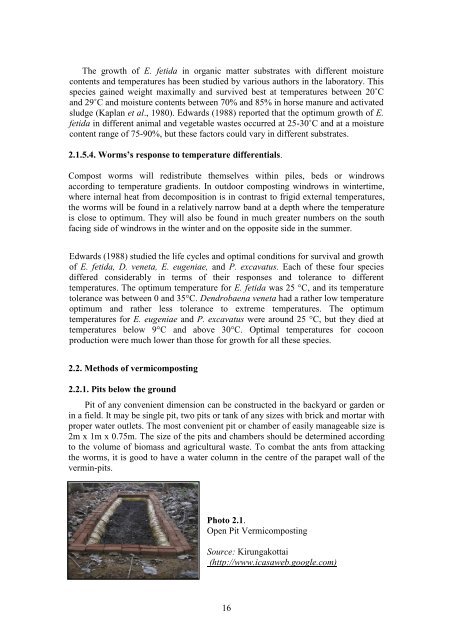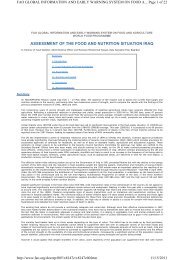Vermiculture in Egypt: - FAO - Regional Office for the Near East and
Vermiculture in Egypt: - FAO - Regional Office for the Near East and
Vermiculture in Egypt: - FAO - Regional Office for the Near East and
Create successful ePaper yourself
Turn your PDF publications into a flip-book with our unique Google optimized e-Paper software.
The growth of E. fetida <strong>in</strong> organic matter substrates with different moisture<br />
contents <strong>and</strong> temperatures has been studied by various authors <strong>in</strong> <strong>the</strong> laboratory. This<br />
species ga<strong>in</strong>ed weight maximally <strong>and</strong> survived best at temperatures between 20˚C<br />
<strong>and</strong> 29˚C <strong>and</strong> moisture contents between 70% <strong>and</strong> 85% <strong>in</strong> horse manure <strong>and</strong> activated<br />
sludge (Kaplan et al., 1980). Edwards (1988) reported that <strong>the</strong> optimum growth of E.<br />
fetida <strong>in</strong> different animal <strong>and</strong> vegetable wastes occurred at 25-30˚C <strong>and</strong> at a moisture<br />
content range of 75-90%, but <strong>the</strong>se factors could vary <strong>in</strong> different substrates.<br />
2.1.5.4. Worms‟s response to temperature differentials.<br />
Compost worms will redistribute <strong>the</strong>mselves with<strong>in</strong> piles, beds or w<strong>in</strong>drows<br />
accord<strong>in</strong>g to temperature gradients. In outdoor compost<strong>in</strong>g w<strong>in</strong>drows <strong>in</strong> w<strong>in</strong>tertime,<br />
where <strong>in</strong>ternal heat from decomposition is <strong>in</strong> contrast to frigid external temperatures,<br />
<strong>the</strong> worms will be found <strong>in</strong> a relatively narrow b<strong>and</strong> at a depth where <strong>the</strong> temperature<br />
is close to optimum. They will also be found <strong>in</strong> much greater numbers on <strong>the</strong> south<br />
fac<strong>in</strong>g side of w<strong>in</strong>drows <strong>in</strong> <strong>the</strong> w<strong>in</strong>ter <strong>and</strong> on <strong>the</strong> opposite side <strong>in</strong> <strong>the</strong> summer.<br />
Edwards (1988) studied <strong>the</strong> life cycles <strong>and</strong> optimal conditions <strong>for</strong> survival <strong>and</strong> growth<br />
of E. fetida, D. veneta, E. eugeniae, <strong>and</strong> P. excavatus. Each of <strong>the</strong>se four species<br />
differed considerably <strong>in</strong> terms of <strong>the</strong>ir responses <strong>and</strong> tolerance to different<br />
temperatures. The optimum temperature <strong>for</strong> E. fetida was 25 °C, <strong>and</strong> its temperature<br />
tolerance was between 0 <strong>and</strong> 35°C. Dendrobaena veneta had a ra<strong>the</strong>r low temperature<br />
optimum <strong>and</strong> ra<strong>the</strong>r less tolerance to extreme temperatures. The optimum<br />
temperatures <strong>for</strong> E. eugeniae <strong>and</strong> P. excavatus were around 25 °C, but <strong>the</strong>y died at<br />
temperatures below 9°C <strong>and</strong> above 30°C. Optimal temperatures <strong>for</strong> cocoon<br />
production were much lower than those <strong>for</strong> growth <strong>for</strong> all <strong>the</strong>se species.<br />
2.2. Methods of vermicompost<strong>in</strong>g<br />
2.2.1. Pits below <strong>the</strong> ground<br />
Pit of any convenient dimension can be constructed <strong>in</strong> <strong>the</strong> backyard or garden or<br />
<strong>in</strong> a field. It may be s<strong>in</strong>gle pit, two pits or tank of any sizes with brick <strong>and</strong> mortar with<br />
proper water outlets. The most convenient pit or chamber of easily manageable size is<br />
2m x 1m x 0.75m. The size of <strong>the</strong> pits <strong>and</strong> chambers should be determ<strong>in</strong>ed accord<strong>in</strong>g<br />
to <strong>the</strong> volume of biomass <strong>and</strong> agricultural waste. To combat <strong>the</strong> ants from attack<strong>in</strong>g<br />
<strong>the</strong> worms, it is good to have a water column <strong>in</strong> <strong>the</strong> centre of <strong>the</strong> parapet wall of <strong>the</strong><br />
verm<strong>in</strong>-pits.<br />
Photo 2.1.<br />
Open Pit Vermicompost<strong>in</strong>g<br />
Source: Kirungakottai<br />
(http://www.icasaweb.google.com)<br />
16





